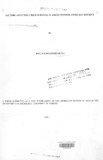| dc.description.abstract | The study focuses on the identification of factors which affect child survival in Asego Division,
Homa-Bay District, Nyanza Province. In 1979, child mortality was highest in Nyanza Province and
CoastProvince, the rates standing at 174 and 177 per 1000 live births, respectively. In 1991, the then
SouthNyanza District of Nyanza Province had the highest Infant and Child Mortality (ICM) rates of
216/1000 live births in the whole country. In 1993, ICM rates in South Nyanza District was
exceptionally high, nearly twice that of the second highest, Coast Province (D.H.S., 1993:85). It is for
thisreason that the research was initiated. The objective of the study was therefore to identify, from
six known factors of ICM, four of these factors, namely:Environmental Factors (household sanitary
standards),Demographic Factors (maternal birth interval and age at first birth), Medical and Health
CareFactors (accessibility of healthcare facilities and most prevalent diseases in the study area) and
Socio-Cultural Factors (breastfeeding practices and the role of education in controlling child death).
The other two ICM factors (political & Economic Factors and Geographical Factors) were not
, consideredas they were beyond the scope of this study and for the fact that the considered Factors are
perhapsthe most crucial. Maternal awareness of the above factors and their health behaviour with
respect to this factors were also highlighted. Two hypotheses were formulated for testing((a)Socioculturalfactors
are associated with ICM rates and (b)Medical and Health Care factors are associated
with ICM factors :in which maternal education was the variable considered under the socio-cultural
factors while accessibility was the variable considered under the Medical and health care factors; in
which the intervening variables were cleanliness/sanitary standard and maternal awarenesslbehaviuor,
foreach hypotheses respectively)
Cluster sampling method was used to pick respondents from one rural Location (E.Kanyada)
and from one urban Location (Homa-Bay Town Location) which were purposely picked to enable a
rural-urbancomparison to be made. Data was collected by use of the interview schedule, direct
observation and unstructured interviews. Secondary data were also used to compare with the results
obtained. Data analysis was both quantitative and qualitative in nature. The Z -test was used for
hypothesistesting while the Chi-square test and the Personian Product Moment of Co-efficient were
usedto test associationsamong variables.
The study revealed that the inhabitants of Asego Division lived in deplorable conditions. Only
16%and 53% of the respondents in East Kanyada and Homa-Bay Locations had toilet facilities. This
represented only 46% of the respondents in Homa-Bay District. Only 56.7% of the inhabitants of
Homa-Bay district practiced hygienic methods of solid waste disposal, whereby 46% and 68% of the
respondents in East Kanyada and Homa-Bay Town locations respectively practiced this. As for wastewater
disposal, only 23.3% of the respondents were found to be practicing hygienic methods of its
disposal. The study also revealed that only 24% of the inhabitants of East kanyada had safe sources of
water while 72% had this in Horna-Bay Town location. this accounted for only 48% for the whole
District.
The study also found out that only 24% of the respondents lived within 2 Km from a health
facility. It was also revealed that maternal health behaviour was also very poor. In relation to action
taken in seeking treatment for a sick child, no respondent was found to prefer taking her child to
hospital for routine medical check-up. The majority of the respondents in E. Kanyanda Location
(38%)unadvisableonly took their children to hospital when they were critically ill, while only 64% of
the inhabitants in Horna-Bay Town Location took their children to hospital when they feel sick. When
it comes to natal care (which has a direct influence in child survival) it was discovered that only 23% of
the inhabitants of Roma-Bay District visited the clinics for complete natal care. In the rural Location,
only 16.4% of the respondents received all the natal care required, while only 41% in Homa-Bay
received the same. The study also showed that measles and malaria are the most prevalent
illnesses/diseases in the two Locations, while measles, respiratory diseases, and diarrhoeal diseases are
the three major killers in these Locations.
On Demographic Factors, the study revealed mean maternal birth interval for Homa-bay
District to be 28.8 months between the first and the second birth and 31.8 months between the last and
previous birth (26.1 months and 30.8 months for E.Kanyada and 33.7 months and 33.1 months for
Homa-Bay,respectively).Mean maternal age at first birth was found to be 17.5 months for the District.
56% of the inhabitants in E.Kanyada Location had had their first birth while they were below 18 years
of age comparedto 53% in Homa-Bay Town Location.
On Socio-Cultural factors, mean months for unsupplemented breastfeeding was found to be
3.9 monthswhich was way below the W.H.O recommended period of six months (4 months and 3.7
months for the rural and urban Location respectively). As for supplemented breastfeeding, the mean
was found to be 23 months (23.1 and 27 months for E.Kanyada and Homa-Bay respectively) which
wasway above the recommended period of 12 months.
On health awareness on the above factors, the study revealed that maternal awareness was
quitelow. The two hypotheses tested were also proven to be true. Socio-Cultural Factors (in this case
maternal education) was found to influence ICM levels as mothers with higher education were found to
maintain a cleaner surrounding that reduced breeding of viruses, parasites and germs which could infect
and kill the under-5. However, for there to be a significant difference among the various educational
levels,one needs to have eight or more years of education for a significant difference to be observed.
Medical and Health Care Factors were also found to be associated with rCM levels. Closer
accessibilityto health facilities positively influenced maternal health behaviour and practices which in
turn acted.positively in ensuring child survival. However, the influence is only observable if one lives within 5km from the nearest health facility.
Hence, certain factors were found to be responsible for the observed high ICM rates while
others were not. | en |

